Tapestry Meaning In The Bible: Symbolism and Significance
In the Bible, tapestries symbolize divine craftsmanship and the interconnectedness of God’s plan for humanity. They were integral to sacred spaces in ancient Israel, such as the Tabernacle, representing divine presence and artistry (Exodus 26).
Proverbs 31:22 underscores weaving as a metaphor for virtue and industriousness, while Esther 1:6 illustrates tapestries’ role in royal grandeur. The intricate designs reflect theological themes, divine providence, and communal bonds, mirroring how God meticulously weaves individual lives into His grand narrative.
Exploring the rich symbolism and historical context of biblical tapestries reveals deeper insights into their spiritual significance and divine orchestration.
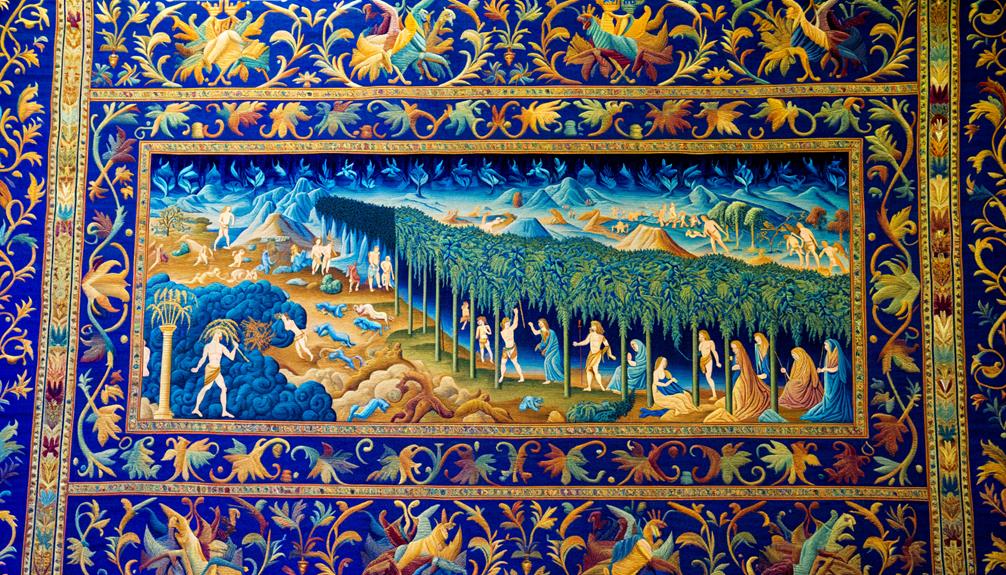
Tapestry Meaning in the Bible: Symbolism and Spiritual Insights
| Symbolic Element | Biblical Meaning | Scriptural Insight |
|---|---|---|
| Intricate Design | God’s detailed plan for humanity | Reflects divine craftsmanship |
| Interwoven Threads | Unity and connection in the body of Christ | Represents spiritual interconnectedness |
| Colorful Patterns | Diversity in God’s creation | Beauty and variety in God’s work |
| Covering and Protection | God’s protection over His people | Symbol of shelter and grace |
| Temple Use | Holiness and sacredness | Used in sacred spaces in the tabernacle |
Historical Context of Tapestries
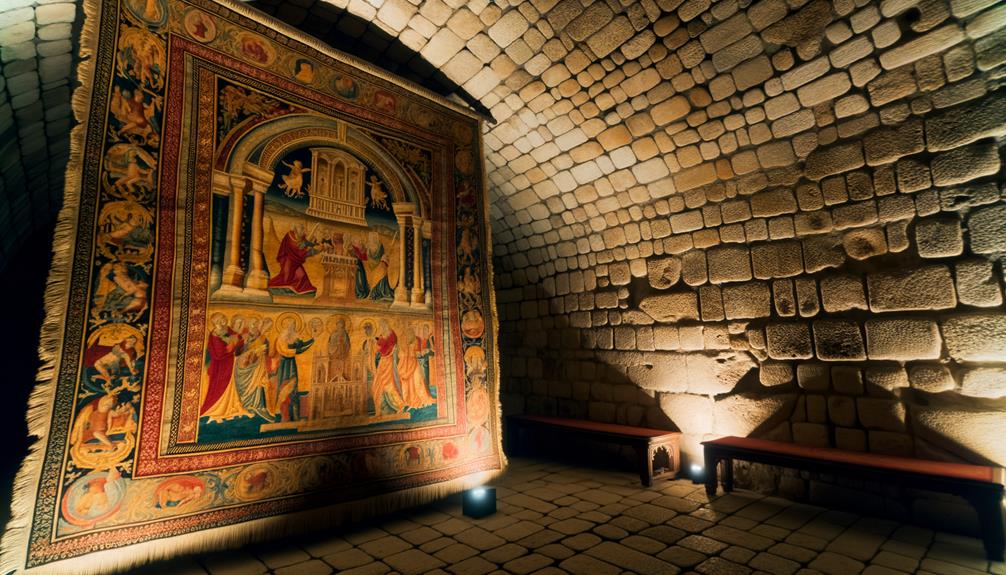
The historical context of tapestries in biblical times reveals their multifaceted roles in both religious and cultural settings, highlighting their significance beyond mere decorative art.
In ancient Israel, tapestries were integral to the sacred spaces of tabernacles and temples, serving as dividers, embellishments, and symbols of divine presence. These woven artifacts often depicted intricate patterns and iconography, reflecting theological themes and the community’s spiritual aspirations.
Culturally, tapestries were also emblems of status and craftsmanship, showcasing the weaver’s skill and the owner’s wealth. By examining archaeological finds and scriptural descriptions, one can discern how these textiles were deeply embedded in the daily and spiritual lives of the people, intertwining artistic expression with devout practice.
Biblical References to Tapestries
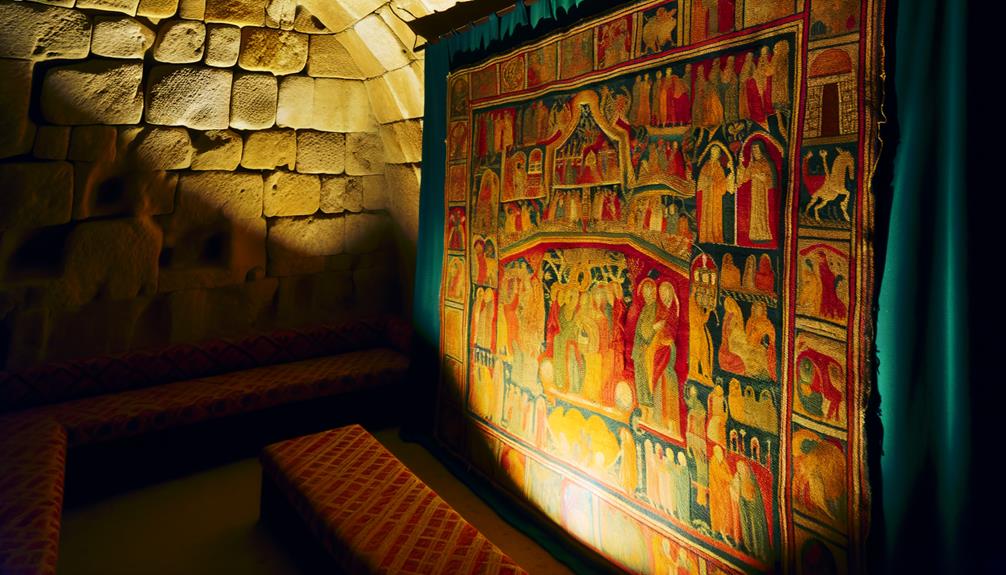
Scriptural texts offer numerous references to tapestries, elucidating their importance in both ceremonial contexts and everyday life within the biblical narrative.
In Exodus 26, the tabernacle’s intricate curtains symbolize divine craftsmanship.
Proverbs 31:22 praises the virtuous woman who weaves tapestries, reflecting domestic skill and diligence.
Esther 1:6 describes the opulence of King Ahasuerus’s palace adorned with tapestries, illustrating royal grandeur.
These references highlight:
- Divine artistry in sacred spaces.
- Domestic virtue embodied by skilled women.
- Royal splendor and its cultural significance.
- Craftsmanship as a reflection of divine order.
Such biblical depictions underscore tapestries’ multifaceted roles, contributing to a deeper understanding of their cultural and spiritual significance.
Symbolism of Interconnectedness

In biblical texts, tapestries often symbolize the interconnectedness of divine, communal, and individual threads woven together to create a cohesive spiritual and social fabric.
This metaphorical weaving signifies how God’s providence, the collective faith of the community, and personal devotion each play integral roles in the broader tapestry of salvation history.
Scriptural references, such as the intricate designs in the Tabernacle’s curtains (Exodus 26:1), underscore the significance of unity and purpose within God’s plan.
The various threads, representing diverse experiences and identities, are harmoniously bound, reflecting the interconnectedness of human lives under divine guidance.
Consequently, the tapestry imagery emphasizes that every believer’s journey is interlinked with the greater narrative of divine orchestration and communal faith.
Divine Craftsmanship Depicted
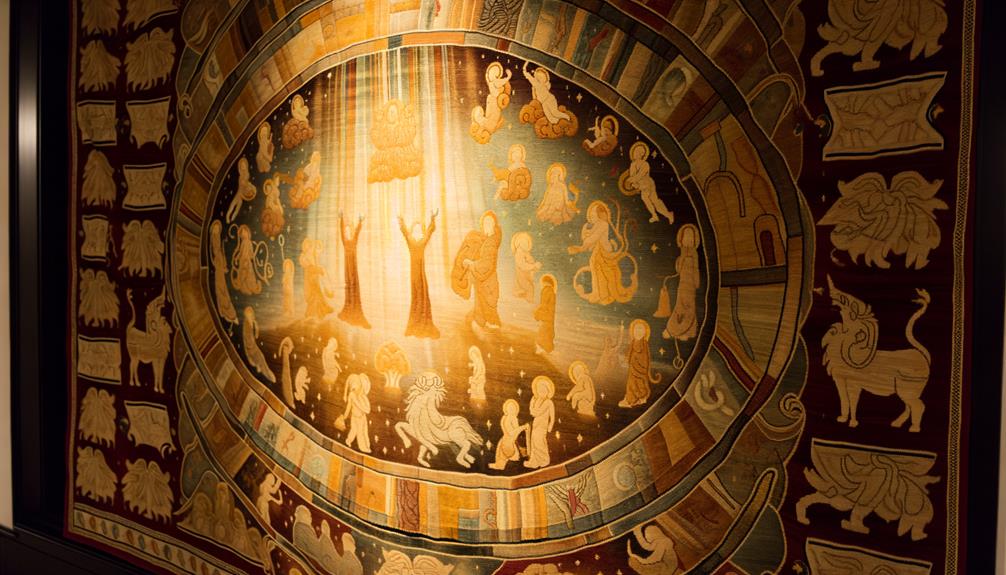
The depiction of divine craftsmanship in biblical texts underscores the intricate design of God’s creation, likening it to the meticulous art of weaving a tapestry.
This symbolism is evident through various scriptural examples, such as the detailed instructions for the Tabernacle’s construction in Exodus, which highlight the intentionality and precision of divine artistry.
These biblical narratives not only reflect God’s creative prowess but also serve as theological metaphors for the interconnectedness and purpose woven into the fabric of existence.
Intricate Divine Design
Biblical narratives often illustrate God’s intricate divine design through vivid metaphors and detailed descriptions of craftsmanship, emphasizing His sovereignty and meticulous care in creation. This divine craftsmanship is not merely a display of skill but a profound expression of God’s intentionality and purpose.
Throughout Scripture, we see:
- The creation of the universe, woven with precision and order (Genesis 1).
- The Tabernacle’s construction, reflecting divine specifications (Exodus 25-31).
- The design of humanity, fearfully and wonderfully made (Psalm 139:14).
- The intricate plans for Israel’s future, divinely orchestrated (Jeremiah 29:11).
These depictions reveal a Creator deeply involved in every detail, showcasing His omnipotence and intimate care.
Symbolism in Weaving
Weaving, as depicted in the Bible, serves as a profound metaphor for divine craftsmanship, illustrating God’s intricate involvement in the fabric of creation and human history. This symbolism underscores the meticulous care and intentionality with which God orchestrates events and lives, weaving together disparate threads to form a cohesive, purposeful design. Historically, weaving was a skilled craft, reflecting the divine artisan’s precision and artistry.
| Biblical Symbolism | Interpretation |
|---|---|
| Thread | Individual Lives |
| Loom | Divine Framework |
| Fabric | History and Creation |
The theological depth of weaving as a metaphor reveals God’s sovereignty and providence. Scriptural analysis of such symbolism illuminates the concept that every thread, though seemingly insignificant on its own, contributes to the grand tapestry of divine intention.
Scriptural Craftsmanship Examples
Often, scriptural narratives vividly portray divine craftsmanship through detailed accounts of God’s interactions with creation and humanity. These depictions serve as profound affirmations to His intricate and purposeful design.
The Bible abounds with examples that illustrate the meticulous nature of divine workmanship:
- Creation of the Universe: Genesis describes God’s methodical formation of the heavens and the earth.
- The Tabernacle: Exodus recounts God’s precise instructions to Moses for crafting a dwelling place.
- Solomon’s Temple: Chronicles detail the grandeur and divine specification of this sacred structure.
- Psalm 139: David poetically acknowledges God’s intimate involvement in human creation.
These instances collectively underscore the Bible’s emphasis on divine intention and precision.
Spiritual Lessons From Tapestries
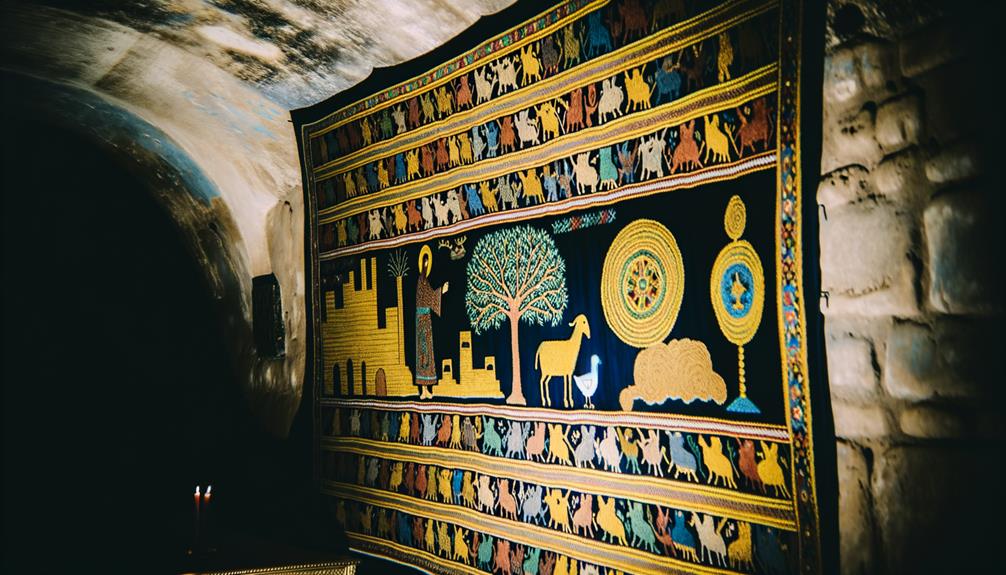
In the intricate designs and vivid colors of biblical tapestries, one can discern profound spiritual lessons that mirror the complexities and beauty of the human soul’s journey with God. These works of art symbolize the interwoven experiences of faith, struggles, and divine intervention. Tapestries serve as a metaphor for the multifaceted relationship between humanity and the divine, illustrating how individual threads of life come together to form a cohesive, meaningful narrative.
| Spiritual Lesson | Biblical Insight |
|---|---|
| Interconnectedness | Each thread represents individual lives, interconnected by God’s divine plan. |
| Divine Craftsmanship | The intricate design symbolizes God’s meticulous care in shaping our destinies. |
| Perseverance | The complexity of tapestries reflects the endurance required in spiritual growth. |
| Redemption | Dark and light threads show the contrast and coexistence of sin and salvation. |
| Purpose | Every strand has a place, illustrating that every life has a divine purpose. |
These spiritual lessons, embedded within the fabric of tapestries, offer a rich tapestry of theological wisdom.
Tapestries in Biblical Narratives
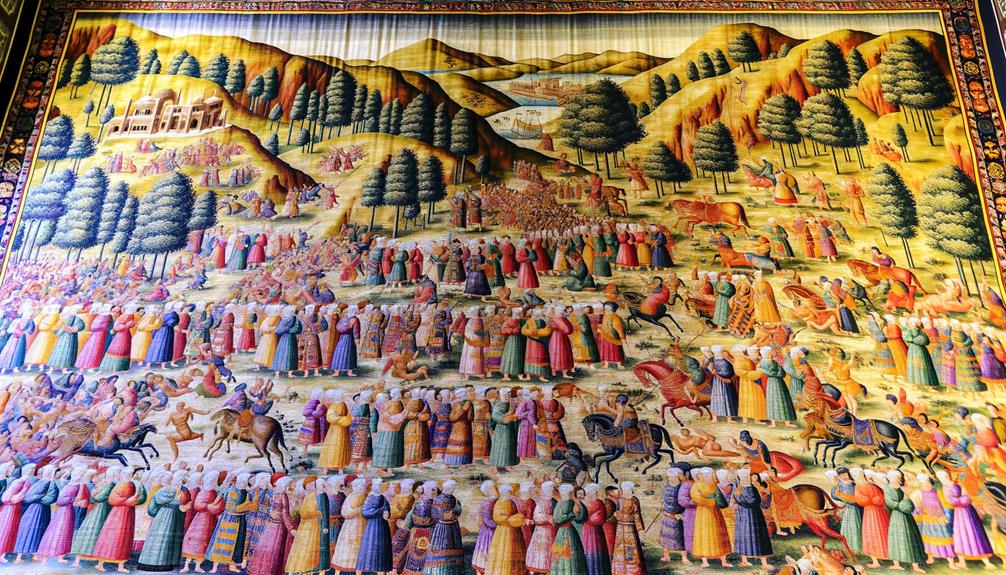
Biblical narratives frequently employ tapestries to convey profound symbolism, offering insights into divine craftsmanship and cosmic order.
These intricate textiles often adorned worship spaces, enhancing the sacred atmosphere and reflecting theological themes.
Understanding the historical context of tapestries in ancient Israel illuminates their role in religious and cultural practices, enriching our interpretation of scriptural accounts.
Symbolism in Biblical Tapestries
Within the rich tapestry of Biblical narratives, tapestries serve as profound symbols that convey divine messages, spiritual truths, and cultural values.
These woven artworks encapsulate:
- Divine Providence: Illustrating God’s intricate plan and omnipresence.
- Spiritual Warfare: Depicting the struggle between good and evil.
- Redemption: Weaving the story of salvation and God’s covenant with humanity.
- Cultural Heritage: Reflecting the traditions, beliefs, and identity of God’s people.
The scriptural references to woven fabrics, such as the veil of the temple (Exodus 26:31-33), underscore their sacredness.
Tapestries in Biblical context often reveal layers of meaning, inviting theological reflection and historical analysis, enriching our understanding of faith.
Tapestries in Worship Spaces
Often seen as sacred art, tapestries in worship spaces serve not only as decorative elements but also as profound theological symbols that enhance the spiritual atmosphere and convey Biblical narratives to the faithful.
These woven masterpieces often depict scenes from Scripture, such as the Creation, the Exodus, and the life of Christ, thereby providing a visual exegesis that complements the spoken word.
By integrating scriptural themes into their designs, tapestries invite congregants to reflect on divine mysteries and truths.
Their presence in sanctuaries and chapels not only beautifies these sacred spaces but also functions as a didactic tool, bridging historical Biblical events with contemporary worship experiences.
Consequently, tapestries play an essential role in the liturgical and catechetical life of the church.
Historical Context of Tapestries
Woven into the fabric of both early Christian worship spaces and the biblical narratives themselves, tapestries hold a storied legacy that reflects the theological and cultural milieu of ancient times.
These intricate textiles not only adorned sacred spaces but also conveyed profound spiritual truths and historical events. Scriptural references, such as the curtain of the Tabernacle, emphasize their symbolic significance.
- Symbolism of divine presence and separation
- Depiction of creation and salvation narratives
- Reflection of socio-political contexts
- Illustration of genealogies and divine covenants
Through these woven masterpieces, the faithful could visually grasp theological concepts and historical epochs, enriching their understanding and devotion.
Each thread and pattern in these tapestries speaks volumes about the divine artistry interwoven with human history.
Modern Interpretations of Biblical Tapestries
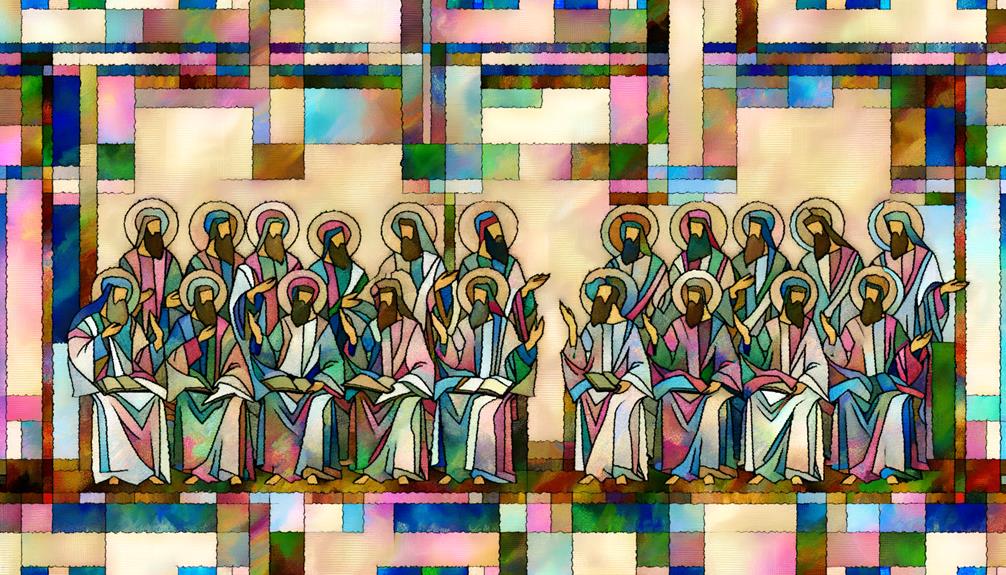
Modern interpretations of biblical tapestries often involve a nuanced exploration of their symbolic significance and theological implications within contemporary Christian thought.
Scholars and theologians analyze these rich textiles as metaphorical representations of divine providence and human destiny, intricately interwoven as described in scripture.
By examining passages such as Isaiah 64:8 and Psalm 139:13-16, which speak of God’s craftsmanship and intimate knowledge of creation, modern interpretations draw parallels between the artistry of ancient tapestries and God’s sovereign design.
Additionally, these interpretations often emphasize the interconnectedness of biblical narratives, symbolizing the unity and diversity of the body of Christ.
In this light, biblical tapestries are seen as profound visual sermons reflecting God’s redemptive plan throughout history.
Conclusion
In the grand tapestry of biblical narratives, tapestries serve as a symbol of divine craftsmanship, interconnectedness, and spiritual lessons.
Woven intricately into the historical and scriptural fabric, they illuminate the profound relationship between the Creator and creation.
As threads of faith and devotion interlace, these sacred textiles reveal divine intentionality and artistry.
Modern interpretations continue to explore their theological depth, ensuring that the rich symbolism of tapestries remains a vibrant and meaningful part of biblical exegesis.






